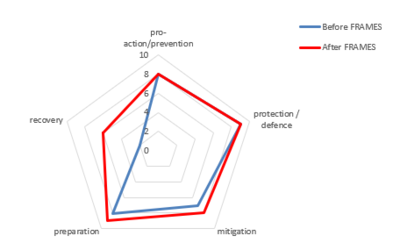Implementation process
By looking at the the activities, actors and methods or approaches used, this section will provide a better understanding of the implementation process of the MLS approach. We will describe the point of departure, who was involved (when, why and how) and what key decisions were made when and why.
Point of departure of FRM strategies
Figure 1: Current and desired score to reach per layer for this pilot (Baseline monitor Sloe area, 2017).
Stakeholders involved
- Province of Zeeland
- North Sea Port (formerly known as Zeeland Sea Ports)
- HZ University of Applied Sciences
- Safety region Zeeland
- Waterboard Scheldestromen
- Rijkswaterstaat
- Companies in the area: Damen, Verbrugge, Kloosterboer en Cobelfret
- Transport companies
- Municipality of Vlissingen
- Municipality of Middelburg
- Owners of infrastructure
- Inhabitants of Souburg, Ritthem, Vlissingen and the area of Middelburg
Roles of key actors
The Waterboard and Rijkswaterstaat are responsible of the first layer; the Safety region is responsible of crisis management, layer 3; Rijkswaterstaat is also partly responsible for layer 3, to protect the roads and make sure they are available for evacuation. The Province is more responsible for layer 2 when possible. When the Safety Region needs to develop evacuation routes and spatial matters are involved, they collaborate with the Province or Rijkswaterstaat for these decisions. HZ University of Applied Sciences can provide support via applied research.
All actors were involved in the whole pilot process. The pilot activities were coordinated by the Province of Zeeland and the HZ University of Applied Sciences. HZ organised the stakeholders’ workshop; the HKV conducted all the data collection and reporting. The Safety Region was involved in organisation the workshops and provide knowledge on crisis management. The owners of the infrastructure and the companies from the harbour were involved in the workshops and in the interviews. They provided knowledge about the safety conditions of the buildings. The municipalities (Vlissingen and Middelburg) got involved later in the process when they understood the relevance of the topic. The water board was involved in the last phase of the project because they were interested in the pilot project outcomes when it comes long term planning and policies. They were not involved in the process because of limited capacity and time.
After FRAMES, it is expected that the Safety Region will take the responsibility to further develop risk communication strategies with inhabitants and improve emergency planning. Likewise, the Province of Zeeland has the responsibility to inform the governors about the pilot project outcomes and to invest in measures further (interview pilot manager, 2020). Moreover the Province of Zeeland is investigating the possibilities for a new project to develop more knowledge on evacuation and shelter locations in Zeeland (final monitoring survey, 2020).
Main activities
In the Netherlands, a distinction is made between preventive evacuation and vertical evacuation. Preventive evacuation means that residents evacuate to a safe place outside the threatened area on the advice of the authorities. A vertical evacuation means that residents are advised not to leave the threatened area and to find a safe place at home on a high floor or in the immediate vicinity (Terpstra and Buijs, 2020).
HKV Lijn in Water (contractor on behalf ofthe Province of Zeeland, pilot manager of the Sloe) conducted a flood risk and spatial analysis of the area to consider opportunities for evacuation (emergency response) in relation to spatial solutions (higher areas, evacuation routes) (Kolen, Rongen and Zethof, 2019). The activities of the pilot project were taken in four steps (interview pilot manager, 2019):
Step 1: Flood risk analysis: The flood risk analysis was done using LIWO to study the most vulnerable houses in case of flooding. It was found out that there was a big difference between the 1:4000 scenario and 1:40.000 scenario. For the scenario of 1:40.000 the whole Walcheren would flood and for the 1:4000 scenario only the ’bathtub Ritthem’ would flood.
Step 2: Research evacuation planning: the options for evacuation roads were looked into, as well as the time needed to evacuate people from the ’bathtub’.
Step 3: Research shelter conditions: once the evacuation roads were identified, the shelter locations were studied. It was researched if the warehouse building in the harbor could be used as a temporary shelter location in case of flooding.
Step 4: Emergency planning and evacuation: during the last step, potential buildings that could be used for vertical evacuation were investigated, as well as what sort of materials were required to survive until the rescue team would arrive.
Referenties
- FRAMES Monitoring survey 8 Zeeland Sloegebied, Akkermans and de Kubber, Province of Zeeland, 31 oktober 2017.
- Transnational Monitor and Evaluation report FRAMES, FRAMES, FRAMES, 8 juni 2020.
- FRAMES Pilot Sloegebied Engelse samenvatting, Kolen, Rongen and Zethof, HKV Lijn in Water, 30 september 2019.
- FRAMES Draagvlak Evacuatie, Terpstra and Buijs, 30 april 2020.

